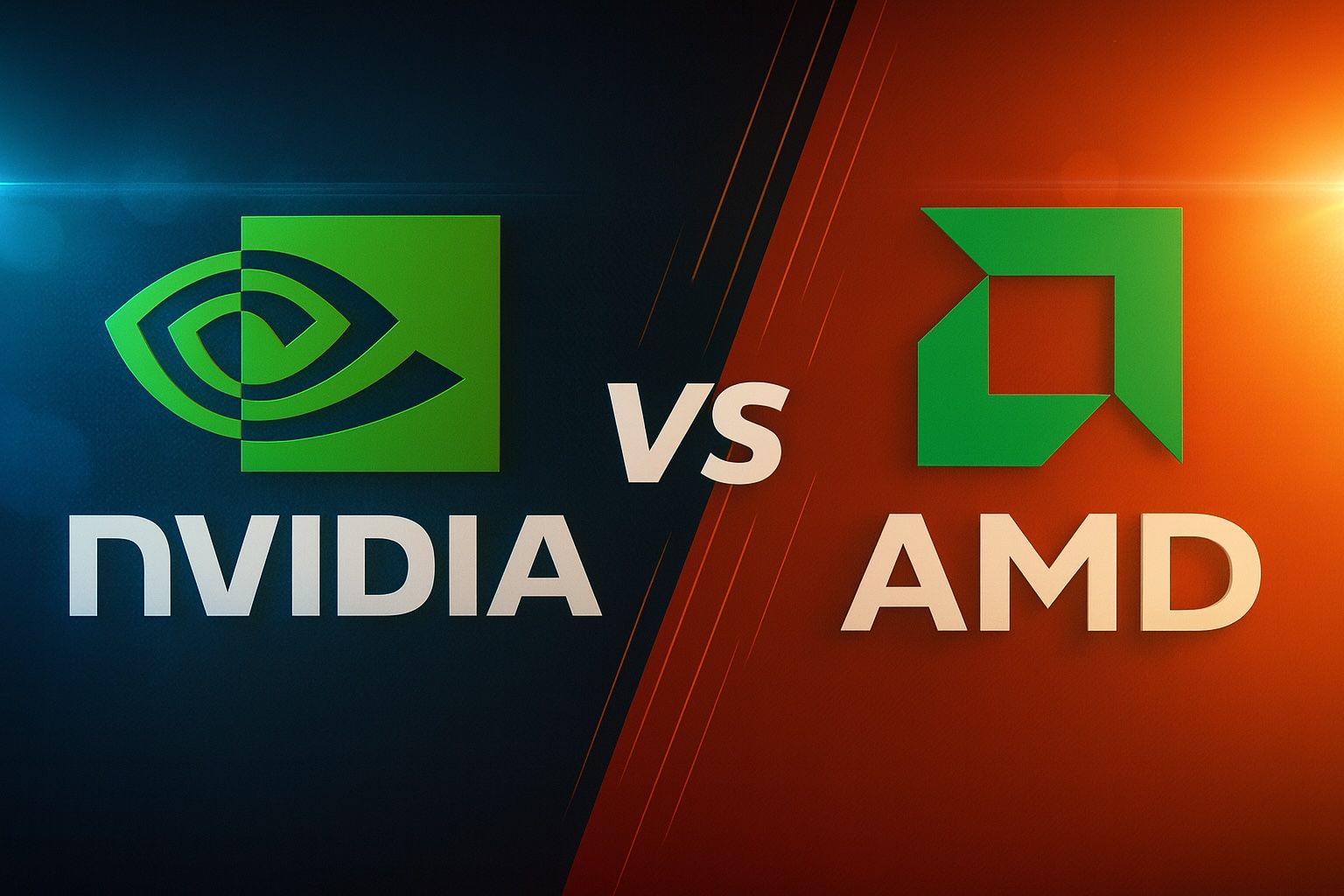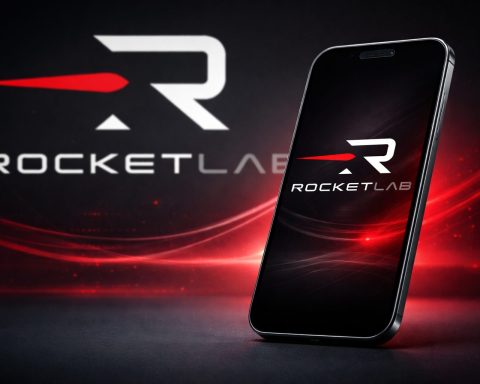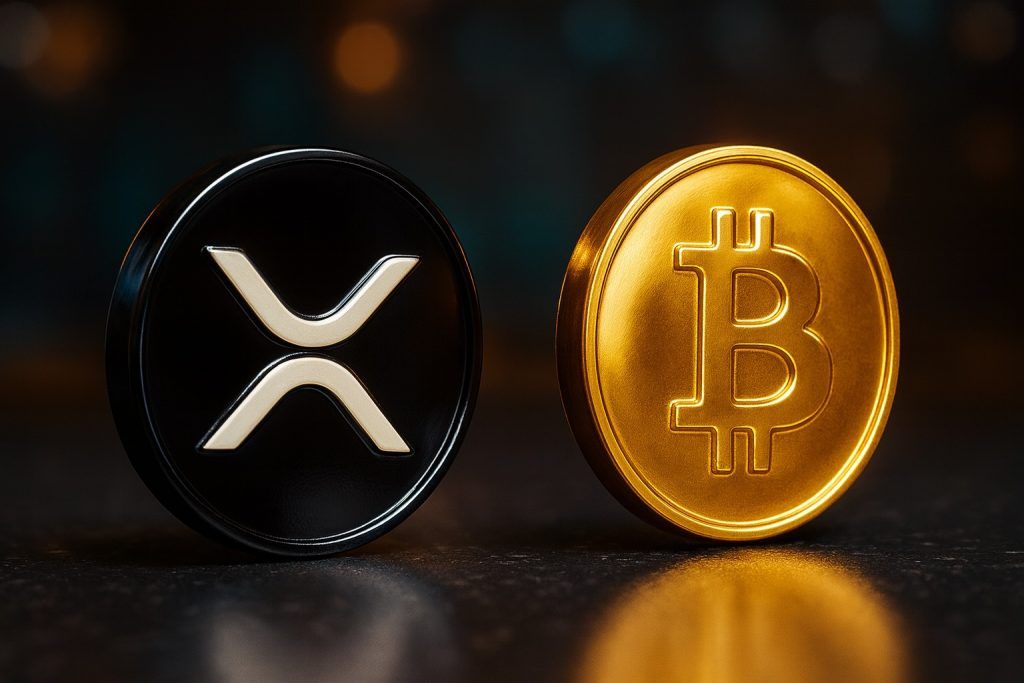- Record Stock Highs: Nvidia’s stock has exploded to all-time highs in 2025, briefly exceeding a $4 trillion market capitalization – at one point making Nvidia the world’s most valuable company [1]. Shares recently traded around $192–$195, roughly triple their value from a year ago amid a frenzy for AI-related stocks [2] [3]. AMD’s stock has likewise skyrocketed – up about 50–60% year-to-date – reaching new multi-year highs around $230–$235 per share [4] [5].
- OpenAI Deals Fuel Rallies: A blockbuster AI chip supply deal with OpenAI sent AMD’s stock soaring ~30% in a single day (Oct. 6, 2025) [6]. AMD will supply hundreds of thousands of GPUs (≈6 GW of compute) to OpenAI starting in 2026, a partnership expected to deliver “tens of billions” in annual revenue and including warrants for OpenAI to buy up to 10% of AMD’s shares at $0.01 each [7] [8]. Nvidia, meanwhile, had already unveiled its own $100 billion+ strategic tie-up with OpenAI in late September – including plans to provide 10 GW of Nvidia hardware and an equity investment by Nvidia in OpenAI [9] [10]. These dueling mega-deals underscore the insatiable AI hardware demand propelling both stocks.
- AI Chip Dominance vs. Challenger: Nvidia still dominates AI and graphics processors, commanding roughly 90–94% of the GPU market thanks to its industry-leading hardware and software (CUDA) ecosystem [11] [12]. It’s selling every AI chip it can produce amid “extraordinary” demand, with revenue last quarter up 56% year-on-year to $46.7 billion at lofty 72% gross margins [13]. AMD, though a distant #2, is rapidly emerging as a credible challenger – its new MI300X accelerators are being tested by major players like Meta, Microsoft and Oracle [14], and the OpenAI win instantly raised AMD’s profile as an alternative supplier in AI chips [15]. AMD is leveraging an open-platform approach (open-source software and standard interconnects) to court customers wary of Nvidia’s more proprietary model [16].
- Valuations and Analyst Sentiment: Both stocks carry premium valuations on AI hype. Nvidia trades around 50× earnings, and AMD about 90× (trailing P/E) – pricing in years of growth [17]. Wall Street remains broadly bullish on both companies’ prospects. Roughly 38 of 45 analysts rate Nvidia a “Buy” with an average 12-month price target near $212 (~15% above current levels) [18]. AMD enjoys a “Strong Buy” consensus as well, with many firms recently hiking targets after the OpenAI deal (e.g. HSBC doubled its target to $200; Jefferies upgraded to Buy with a Street-high $300 target) [19]. However, even supporters warn that today’s prices “bake in” perfection [20] – any stumble (e.g. product delays, slower AI uptake, or macro headwinds) could trigger sharp pullbacks in these high-flying stocks [21].
- Beyond AI – Gaming & Auto: In gaming GPUs, Nvidia maintains a sizeable lead in market share and mindshare, with its GeForce RTX series widely regarded as the high-end standard. AMD’s Radeon GPUs compete on value and are used in all major game consoles (Sony PlayStation 5, Microsoft Xbox Series), but recent reports indicate Nvidia now accounts for roughly 80–90% of discrete PC graphics card shipments [22]. In automotive semiconductors, Nvidia has been a pioneer, supplying its DRIVE chips and AI software to many self-driving and driver-assistance programs (from Mercedes-Benz to robo-taxi startups). Its growing presence in auto tech is such that Nvidia even faced a recent trial over allegedly stolen self-driving trade secrets [23]. AMD’s automotive foothold is smaller – it provides high-performance Ryzen Embedded processors for in-vehicle infotainment systems (as seen in newer Teslas, for example) [24] and inherits some automotive-grade FPGA business via its Xilinx acquisition – but AMD is not yet a major player in autonomous driving platforms. Both companies see growth opportunity in these segments, though the data-center AI boom remains the primary stock driver in 2025.
Stock Performance & Financial Snapshot (YTD 2025)
After a turbulent 2024, both Nvidia and AMD have staged massive rallies in 2025 amid the AI frenzy. Nvidia’s share price has climbed roughly 30% year-to-date (on top of a 171% surge in 2024) [25], while AMD’s stock has risen a similar ~30% YTD (after an 18% drop last year) [26] – and much more if measured from its early-2025 lows. In fact, AMD’s late surge in the first week of October pushed it to about +50–60% for the year overall [27].
As of Oct 10, 2025, Nvidia (NVDA) trades around $192–$193 per share [28], and AMD (AMD) around $230–$233 [29] – both near their highest levels ever. Nvidia briefly hit $195.30 this week (a record intraday high) [30], giving it a staggering $4 trillion+ market capitalization [31]. That valuation is nearly an order of magnitude larger than AMD’s (which jumped to roughly $320–330 billion in market cap after the OpenAI deal) [32]. By market cap, Nvidia now eclipses even tech giants like Apple and Microsoft during intraday trade [33], whereas AMD – despite its rapid ascent – remains the third-most valuable semiconductor firm, behind Nvidia and TSMC [34].
Such lofty valuations reflect enormous growth expectations. Nvidia’s stock currently trades at about 50 times its trailing 12-month earnings [35]. AMD’s multiple is even higher, roughly 90× trailing earnings (and ~50–60× forward earnings) [36], as investors price in the company’s new AI revenue opportunities. For context, these far exceed the S&P 500’s P/E and leave little room for error – a point noted by skeptics who warn that any slowdown or execution slip could spur dot-com-bubble-style volatility [37] [38].
Key financials underscore both the gap and the growth between the two rivals. Nvidia is on pace for an astounding >$200 billion in annual revenue in its current fiscal year [39], turbocharged by the AI boom. In the most recent quarter, Nvidia’s sales exploded 56% year-over-year to $46.7 billion with exceptionally high margins [40]. It even raised guidance to ~$54 billion for next quarter – signaling further growth acceleration [41]. AMD, by contrast, is expected to pull in around $32–33 billion revenue for 2025 [42] – only about one-sixth of Nvidia’s – with a business model that yields slimmer margins (AMD has been reinvesting heavily in R&D and integration of past acquisitions) [43]. AMD’s trailing 12-month revenues are in the ~$25–30 billion range [44], and it remains profitable and cash-flow positive, but its current sky-high stock price is banking on future gains from recent strategic wins.
Notably, AMD has no dividend and instead plows cash back into growth initiatives [45], whereas Nvidia pays a token dividend (and has done massive share buybacks in recent years) – though for both, share price appreciation has been the real reward to investors. By most measures, Nvidia’s financial scale dwarfs AMD’s: Nvidia’s annual sales are about 5× AMD’s and its market cap about 12–15× larger [46], yet AMD’s nimble rise from near-obscurity a decade ago to a $300B+ valuation today is one of tech’s great turnaround stories [47]. In 2012 AMD was valued under $2 billion [48]; today it’s challenging giants, thanks to leadership under CEO Lisa Su. Both stocks have vastly outperformed the broader market this year – a reflection of investors “rushing to capitalize on booming AI” opportunities [49] – but with that momentum comes the risk of outsized swings if sentiment changes.
Recent News Catalysts (Early October 2025)
The first weeks of October 2025 brought major news for both Nvidia and AMD, further defining their rivalry in the “AI gold rush”:
- AMD’s Blockbuster OpenAI Deal: On Oct. 6, AMD announced a multi-year partnership with OpenAI (creator of ChatGPT) to supply enormous quantities of AI accelerators. The deal covers roughly 6 gigawatts of computing capacity – translating to hundreds of thousands of high-end AMD “Instinct” GPUs to be delivered starting in late 2026 [50]. AMD executives estimate it could generate “tens of billions of dollars” in annual revenueonce fully ramped, and over $100 billion in total revenue across the next four years when factoring in other customers likely to be drawn by this partnership [51]. In exchange, OpenAI received a special warrant to purchase up to ~10% of AMD’s shares at $0.01 each (vesting as certain deployment milestones and stock-price targets are met) [52]. This effectively gives OpenAI a significant stake in AMD’s success – aligning both parties’ incentives to make the collaboration work.The news was met with euphoria in the market. AMD’s stock surged 30–34% on Oct. 6 – its largest one-day gain in 9+ years – adding about $80 billion to AMD’s market cap overnight [53] [54]. Analysts called the agreement a “major vote of confidence” in AMD’s AI technology [55]. AMD’s data-center chief Forrest Norrod told Reuters the deal is “certainly transformative” not just for AMD but for industry dynamics [56]. Indeed, landing OpenAI – one of the most coveted AI customers – instantly elevates AMD’s credibility in AI. It “gives AMD one of the premier seats at the table” in the AI computing race, as one analyst put it [57].Context: Just days prior, rumors had swirled that OpenAI might develop its own AI chips (with help from Broadcom), which knocked AMD’s stock down ~5% in late September [58]. That narrative flipped overnight – instead of being left out, AMD secured the marquee AI chip contract. The deal’s structure also underscores OpenAI’s voracious need for hardware. OpenAI isn’t dropping Nvidia entirely – in fact, a month earlier OpenAI expanded its purchases from Nvidia with a separate ~$100 billion supply deal [59] – but the AI startup is clearly hedging its bets and seeking multiple suppliers (Nvidia and AMD, plus others for memory chips) to avoid bottlenecks [60]. OpenAI CEO Sam Altman hailed AMD’s new chips as “a major step” toward building the compute needed for AI’s full potential [61]. For AMD, the hard work lies ahead: it must execute on delivering cutting-edge GPUs at huge scale by 2026–2027. If it succeeds, AMD stands to fundamentally expand its business; if it stumbles, the stock’s recent gains could prove fleeting.
- Nvidia’s $100 Billion OpenAI Alliance (and Other Deals): Nvidia responded to the AI demand in late September with its own blockbuster announcement: a letter of intent to invest up to $100 billion in OpenAI and become a key supplier/partner to the firm [62] [63]. Under that proposed partnership, Nvidia will provide at least 10 GW of its next-gen AI systems to OpenAI (on a similar timeframe, starting ~2026) and take a financial stake via non-voting shares [64] [65]. Essentially, Nvidia would help bankroll OpenAI’s massive expansion, ensuring OpenAI has priority access to Nvidia’s cutting-edge GPUs (the deal was described as “everything starts with compute,” per Altman [66]). Analysts noted the unusual “circular” nature – Nvidia’s cash enabling OpenAI to buy Nvidia chips [67] – but overall saw it as shoring up Nvidia’s lock on a top customer. Nvidia’s stock jumped ~4% on that Sept. 22 announcement to new highs [68] (Oracle’s stock also rose, given Oracle’s role hosting OpenAI’s compute [69]). Regulators, however, have since mused about potential antitrust questions from tying the world’s dominant AI chipmaker with its leading AI software customer so tightly [70].Nvidia wasn’t done making headlines: in an unprecedented twist, Nvidia also took a $5 billion stake in Intel in late September – acquiring ~4% of Intel’s shares [71]. This move, confirmed by both companies, aims to foster collaboration on certain data-center and PC chip initiatives [72]. It sent Intel’s beaten-down stock up 20%+ on the news [73]. The partnership does not extend to Intel’s foundry business (i.e. Nvidia isn’t having its GPUs made at Intel fabs at this point) [74], but it does signal a thaw in the historic Nvidia–Intel rivalry. With the industry scrambling to meet AI demand, new alliances are forming: “It’s Nvidia’s world, with everybody else paying rent,” one tech analyst quipped, noting that even arch-competitors are now finding common cause against the Nvidia juggernaut [75] [76]. Intel itself, though not a focus of this report, has been the beneficiary of government aid (a U.S. government fund took a ~10% stake in Intel earlier in 2025) and is striving to catch up in chip manufacturing and AI – now with a bit of help from Nvidia [77] [78].Additionally, Nvidia announced a flurry of other partnerships: for example, Alibaba disclosed it will integrate Nvidia’s AI solutions into its cloud, which sent Alibaba’s stock up ~10% [79]. And in a sign of how global the AI race has become, Japan’s SoftBank invested $2 billion to become a top-10 shareholder in Intel around the same time [80] – a vote of confidence in chip demand (SoftBank’s CEO is betting on an “AI revolution”). All these moves contributed to what one publication called an “AI frenzy adding $200 billion to chip stocks” in early October [81]. It’s a boom unlike anything in recent memory for the semiconductor industry, and both Nvidia and AMD have been at the center of it.
- Strategic “Coopetition” – AMD & Intel Foundry Talks: Another notable development is the report that AMD and Intel are in early talks for Intel to produce chips as a foundry for AMD [82]. This would have been unthinkable years ago – Intel and AMD have been bitter CPU rivals for decades – but times are changing. AMD is fabless (relying on TSMC to manufacture its designs), and the crush of AI chip demand has raised concerns about limited manufacturing capacity. Intel has been pouring investment into its new Intel Foundry Services and is eager to attract big customers. According to Reuters, Intel and AMD began discussing a potential foundry deal (first reported by Semafor on Oct. 1) [83], which could give AMD a second source of advanced chips made on U.S. soil [84]. While no deal is finalized (and any production would be a few years out), the fact they’re even negotiating underscores how the industry is bending old rivalries. If Intel’s upcoming process nodes prove competitive (Intel aims to rival TSMC’s technology by 2025–26), AMD could benefit by diversifying its supply chain [85]. This kind of “coopetition” – cooperation between competitors – highlights the new reality: surging AI demand is forcing companies to partner in unusual ways to crank out more chips. In the end, everyone is racing to avoid being capacity-constrained in the face of unprecedented orders.
- Other Notable News: AMD in late September also expanded a partnership with Cohere, a rising AI startup focusing on large language models for enterprises [86]. Cohere will utilize AMD’s Instinct GPUs for certain cloud services, offering its customers an alternative to Nvidia-based infrastructure, and AMD will in turn use some of Cohere’s AI tech internally [87]. This showcases AMD’s strategy of positioning itself as a cost-effective, open alternative for AI computing – appealing especially to business and government customers that want diversity in their suppliers or need more control over data (so-called “sovereign AI” projects) [88]. Nvidia, for its part, has been pushing into new areas as well – from building an AI “Omniverse” simulation platform to releasing open-source robotics tools – to extend its reach beyond chips [89] [90]. In short, both companies are aggressively broadening their ecosystems: AMD via collaborations and open-systems, Nvidia via end-to-end platforms and software, all in service of cementing their roles in the AI era.
AI & Data Center Chips: Nvidia’s Lead and AMD’s Ambitions
The centerpiece of the Nvidia vs. AMD battle in 2025 is the market for AI accelerators – high-performance chips used in data centers to train and run advanced AI models. Here, Nvidia has been the unquestioned leader, but AMD is mounting its strongest challenge yet.
Nvidia’s dominance in this arena has been decades in the making. Its GPUs (graphics processing units), once aimed mainly at video games, proved brilliantly suited to parallel computing tasks like neural-network training. Nvidia invested heavily not just in hardware but in software – its CUDA programming platform and AI libraries – creating a virtuous cycle where researchers and developers gravitated toward Nvidia hardware. As a result, Nvidia today holds an estimated 90%+ share of the AI processor market (by some measures 94% share) [91] [92]. Its current flagship, the H100 data-center GPU, is considered the “gold standard” for training large AI models [93]. Demand for H100s (and related systems like Nvidia’s DGX servers) has vastly outstripped supply in 2023–2025, contributing to the shortage of AI compute. Nvidia has been likened to an “AI picks-and-shovels” supplier, selling the critical hardware to virtually every major AI effort. This has translated into stunning financial results – e.g. Nvidia’s data-center revenue last quarter doubled year-on-year, driving those record earnings [94]. Importantly, Nvidia’s ecosystem advantage is a wide moat: beyond silicon, it offers networking gear (from its Mellanox acquisition), AI software frameworks, and cloud services, aiming to make Nvidia the indispensable backbone of AI computing [95] [96].
AMD’s push into AI accelerators has accelerated in response to Nvidia’s success (and the massive opportunity). Historically, AMD was known for CPUs and as a smaller competitor in GPUs. In recent years, under CEO Lisa Su, AMD has acquired GPU-focused companies (like ATI long ago) and more recently Xilinx (FPGAs) and Pensando (DPUs) to broaden its portfolio. AMD’s high-performance CPUs (EPYC for servers) have already made headway against Intel in cloud and enterprise markets, and now AMD is turning that engineering prowess to GPUs for AI. Its latest data-center GPU line is the MI300 series (“Instinct” accelerators), which includes the MI300X – a GPU optimized for large AI models – and MI300A, which combines CPU+GPU in one package for HPC use. AMD unveiled the MI300X in mid-2023 and is planning a next-gen MI400 series in 2026 [97]. Critically, AMD has positioned these as more open alternatives to Nvidia. AMD’s software stack (ROCm) is open-source, and its systems use standard interfaces like PCIe and Ethernet rather than proprietary Nvidia tech – an approach that appeals to some cloud players who don’t want to be locked into one vendor [98].
In 2025, we’re seeing the first signs that AMD’s strategy is gaining traction. Major hyperscalers are testing or deploying AMD’s MI300X GPUs – including Meta (Facebook’s parent), Microsoft, Oracle, Amazon AWS, and others in various reports [99]. While these deployments are still limited, they indicate serious interest in a second source besides Nvidia. OpenAI’s deal with AMD – potentially the largest GPU order ever placed outside Nvidia – is the strongest validation yet that top-tier customers “want a Plan B” in case Nvidia can’t meet all their needs or to improve bargaining power [100] [101]. As one analysis noted, the OpenAI win could generate “tens of billions in annual revenue for AMD” and marks it as an emerging alternative in AI chips [102] [103].
That said, Nvidia maintains a sizable lead. Even after AMD’s announcements, analysts estimate Nvidia still has over 90% of the accelerator market and a multi-year head start in software support [104]. Nvidia’s next-gen GPU architecture (codename “Blackwell”) is reportedly around the corner, promising another leap in performance; CEO Jensen Huang described the upcoming chips as delivering exceptional gains with “extraordinary demand” already lining up for them [105]. Nvidia’s incumbency means many AI developers are deeply invested in its CUDA ecosystem, which isn’t trivial to switch away from. This inertia can make it challenging for AMD to win certain customers unless AMD significantly outperforms on cost or openness.
Looking forward, the competition will hinge on execution. AMD must deliver on its roadmap – e.g. successfully launching the MI350/MI400 series by 2026 and scaling up manufacturing – to narrow the gap. The OpenAI deal includes co-designing chips (the future MI450 GPU) with OpenAI’s input [106] [107], which could give AMD an edge in tailoring products for a key customer. By late 2026 or 2027, if AMD’s MI450 meets its targets, some experts believe the performance gap with Nvidia could shrink considerably [108]. More broadly, other challengers like Google’s TPU, startup accelerators, or even Intel’s forthcoming GPU efforts (e.g. Intel’s acquired Habana Gaudi chips) are also trying to chip away at Nvidia’s lead. For now, though, Nvidia’s end-to-end platform and first-mover advantage keep it in pole position [109]. One investment advisor commented that Nvidia’s current momentum “reminded me of 1999” in terms of exuberance [110] – but also acknowledged that unlike many dot-com era firms, Nvidia has very tangible dominance in a crucial industry.
In summary, Nvidia is the clear leader in AI chips, but AMD has gone from virtually absent to a viable contender. The dynamic resembles a classic incumbent vs. upstart: Nvidia enjoys the lion’s share of profits today, while AMD is trying to ride the next wave and grow into its valuation tomorrow. From an investor’s viewpoint, Nvidia offers the confidence of market leadership (with all the pricing power and profitability that implies), whereas AMD offers higher-risk, higher-reward upside if it can carve out a bigger slice of the exploding AI market. Both are poised to benefit if the overall “AI hardware pie” keeps growing – indeed, OpenAI’s strategy to use both Nvidia and AMD shows the AI market is expanding so fast that one supplier can’t do it all [111] [112].
Gaming GPUs Showdown
Outside of AI/data centers, Nvidia and AMD continue to compete in their more traditional battleground: consumer and gaming graphics processors. While this segment hasn’t driven the 2025 stock narrative as much as AI has, it remains an important business (and technology driver) for both companies.
Market share: Nvidia has long led in discrete desktop GPU sales, and its lead has only grown recently. Industry reports in 2025 suggest Nvidia now accounts for anywhere from ~80% to over 90% of add-in GPU card shipments, leaving AMD with most of the remainder [113] [114]. (One analysis of Q2 2025 put Nvidia at 94% share to AMD’s 6%, a statistic that – if accurate – underscores how dominant Nvidia is in the current generation of PC graphics cards [115].) The reasons are multifold: Nvidia’s GeForce RTX series (most recently the 40-series “Ada” GPUs) generally tops performance benchmarks and supports popular proprietary features like DLSS (AI-based upscaling) and more mature ray-tracing, which many high-end gamers and game developers prioritize. Nvidia’s brand is very strong among gamers/enthusiasts, which translates to robust demand even at premium prices.
AMD’s Radeon RX series (currently RX 7000-series with RDNA3 architecture, launched in late 2022) offers competitive performance-per-dollar and efficiency, but AMD has struggled to dent Nvidia’s high-end dominance in this cycle. Some of AMD’s GPUs (like the RX 7900 XTX) are certainly powerful, yet Nvidia has captured mindshare with features like DLSS 3 and broad developer optimizations. Notably, AMD does have one huge win in gaming – consoles.AMD provides the custom APUs (combined CPU/GPU chips) inside Sony’s PlayStation 5 and Microsoft’s Xbox Series X|S. Those consoles, released in late 2020, saw record sales through 2021–2023 and continue to be hot sellers. While console chip revenues are lower margin than high-end PC GPUs, they give AMD a steady stream of business and a large user base using AMD graphics technology. Nvidia, by contrast, is absent from the current big consoles – it last had a console win with the Nintendo Switch (launched 2017 with an Nvidia Tegra chip). There are rumors a next-gen Switch might also use Nvidia, but in the core PS/Xbox arena, AMD is the exclusive supplier. This means virtually all AAA game developers are optimizing for AMD GPU hardware in consoles, which could benefit AMD’s ecosystem (though on PC, many games still run best on Nvidia due to driver/software differences).
Product cycle: As of late 2025, gamers are looking ahead to the next generation from both companies. Nvidia’s next GeForce architecture (potentially codenamed “Blackwell” for consumer GPUs) is expected perhaps in 2025–2026, and enthusiasts are already speculating on performance leaps. AMD is similarly working on its next GPU architecture (reports of “RDNA4” or even a hybrid “UDNA” for unified console/PC architecture) [116]. For now, both companies have refreshed their lineups through 2024, filling out their product stacks (from budget GPUs up to halo enthusiast cards). One interesting trend is the crossover of AI and consumer graphics: Nvidia is reportedly enabling some of its AI acceleration features on consumer cards (e.g. using GeForce cards for AI workload demos), and AMD’s newest GPUs also emphasize AI-oriented instructions. This blurring could mean future gaming cards from both also double as AI accelerators for hobbyists or small labs – a minor factor, but worth noting as part of the AI influence.
Crypto and demand swings: The PC graphics market in recent years has also been buffeted by cryptocurrency mining demand (which heavily favored Nvidia in the 2020–21 boom, then crashed). By 2025, crypto mining on GPUs has faded in importance due to changes in Ethereum and others, which is a relief for gamers (less GPU shortage). However, a new kind of “AI mining” – companies and individuals buying GPUs for AI workloads – has partially replaced it. Here again Nvidia benefited greatly (its RTX 4090, while a gaming card, is also a beast for AI model training, leading some AI startups to repurpose them). AMD’s cards are capable too, but Nvidia’s software stack made them easier to integrate for AI. This dynamic has kept Nvidia’s gaming revenues fairly robust; in its financial reporting, Nvidia actually had a downturn in gaming in 2022 but saw a rebound in 2023–2024 as excess inventory cleared and new games plus some AI usage drove demand. AMD’s gaming segment revenue has been more flat, as gains in console shipments offset some decline in PC graphics share.
Outlook: Going forward, the gaming GPU segment is a more zero-sum contest between Nvidia and AMD (unlike AI, where demand is expanding so fast both can win). It’s likely Nvidia will maintain its sizable lead in PC graphics in the near-term – especially at the high end – given its product strength and larger R&D budget (which allows very fast release of things like DLSS updates, Game Ready drivers, etc.). AMD, however, often competes well in the mid-range and offers gamers strong value (more VRAM or performance per dollar). If economic conditions tighten, that value angle could help AMD capture budget-conscious buyers. Additionally, any major misstep by Nvidia (such as a new GPU launch with supply issues or unpopular pricing) could open the door a bit wider for Radeon. Both companies also face a potential longer-term threat from Intel’s entry into GPUs (Intel Arc graphics), but so far Intel’s impact has been minimal. All told, gaming remains an important cash cow for Nvidia and a solid business for AMD – but in the big picture of 2025, it’s somewhat overshadowed by the exponential growth and strategic importance of the AI/data-center side.
Automotive and Other Emerging Segments
Another arena of competition is automotive and edge AI chips, though here the dynamics are quite different. Nvidia has invested heavily in automotive computing over the past decade, while AMD’s presence is newly developing (partly via its Xilinx acquisition).
Nvidia in automotive: Nvidia’s DRIVE platform – encompassing system-on-chips (SoCs like Orin and the upcoming Thor), plus sensors and autonomous driving software – has made Nvidia a leading partner for many automakers pursuing self-driving cars or advanced driver-assistance systems (ADAS). Companies like Mercedes-Benz, Volvo, Audi, Tesla (earlier models), and many EV startups have at times announced using Nvidia chips for AI-driven features. For example, Mercedes is rolling out Level-3 autonomous capabilities using Nvidia’s platform, and China’s NIO uses Orin in some models. While the revenue from auto is still relatively small for Nvidia (a few hundred million per quarter), the pipeline is huge – Nvidia has stated it has over $10 billion in automotive order backlog for the coming years. Crucially, automotive deals are long-term and strategic: if Nvidia’s hardware and software power a car’s AI, it often means ongoing revenue from software updates, maps, and future upgrades.
Nvidia’s aggressive push into self-driving tech hasn’t been without controversy. Just recently, a former employee of a supplier (Valeo) alleged Nvidia poached them and stole trade secrets related to self-driving tech, leading to a legal battle heading to trial in late 2025 [117]. Nvidia strongly denied wrongdoing, but the case highlights that as Nvidia expands into new domains (like autonomous vehicle software), it can become a target for IP disputes and scrutiny. There’s also regulatory risk: highly advanced chips for autonomous AI might fall under the same export controls as other AI chips when it comes to sales in China (where many EV startups would love to use Nvidia – a parallel to the data-center GPU restrictions).
AMD in automotive: AMD’s role in the car market has been quieter but not absent. Thanks to Xilinx, which AMD acquired in 2022, AMD inherited a portfolio of automotive-grade FPGA and adaptive chips used in things like driver assist, infotainment, and 5G connectivity for cars. Xilinx’s FPGAs were popular in some ADAS sensor processing and in-car networks. Additionally, AMD’s standard processors and GPUs have found a niche in infotainment systems – the entertainment and navigation screens in vehicles. Notably, Tesla’s newer Models (3/Y and S/X refresh) use an AMD Ryzen CPU and AMD GPU to power the dashboard interface and even gaming on the center screen. Other car makers have also worked with AMD for infotainment: e.g., some trim levels of the 2022+ Mercedes-Benz C/E class reportedly use AMD chips for the MBUX infotainment system, and Jeep/Chrysler have used AMD’s embedded APUs in their Uconnect systems. AMD’s own marketing touts that its embedded Ryzen processors bring “leading 3D graphics performance and 4K multimedia” into vehicle infotainment [118]. This is a growing market as cars incorporate more screens and entertainment options (even passenger-side displays).
Where AMD has not yet made a play is in the central “brain” for autonomous driving – the territory dominated by Nvidia, Mobileye (Intel), and some startups. However, given AMD’s general push into AI, it’s conceivable AMD could repurpose its AI accelerators or FPGAs for automotive AI uses in the future. For now, AMD’s automotive revenue is a small piece of the pie (likely lumped into its embedded segment).
Edge and other segments: Both companies also target “edge computing” applications – think AI at the edge (in devices like drones, factory robots, IoT gateways). Nvidia’s small Jetson modules are popular for robotics and edge AI. AMD, via Xilinx, offers adaptive SoCs that combine CPUs, GPUs, and FPGA fabric for edge uses. These markets are nascent but could expand with the proliferation of AI outside data centers.
In summary, Nvidia holds a stronger hand in automotive AI, aligning with luxury and tech-forward car brands to supply the brains of self-driving systems. AMD’s role is currently more peripheral – providing chips that make the in-car experience richer – but it has technological pieces (high-performance CPUs, FPGAs, and GPUs) that could be assembled into future automotive solutions. For both companies, the automotive sector hasn’t materially moved the stock needle yet, but it represents a significant long-term opportunity (the convergence of cars and high tech). As self-driving capabilities inch forward, it will be interesting to watch if AMD decides to more directly challenge Nvidia here, or if it continues focusing primarily on data center and PC markets in the near term.
Wall Street’s View & Investment Outlook
The dramatic rise of Nvidia and AMD in 2025 has attracted intense attention from analysts and investors, with generally optimistic outlooks tempered by reminders of risk. Here’s how experts see the two stocks:
Analyst sentiment is largely bullish. Nvidia is almost universally loved by covering analysts: about 38 of 45 analystsrate it a “Buy”, with the rest mostly “Hold” and only a token few “Sell” ratings [119]. The average 12-month price target is ~$212 for NVDA [120], implying moderate upside from current levels. Many analysts raised their targets after Nvidia’s blowout mid-year earnings – for example, Citigroup boosted its target to $210 and Barclays to $240 [121]. A few extremely bullish calls grabbed headlines: one veteran tech analyst went to $275 (around +45% potential) arguing that the market underestimates Nvidia’s growth runway [122]. Cantor Fitzgerald even reportedly suggested Nvidia could be on a path to a $10 trillion market cap in the long run, if AI truly transforms the economy as expected [123]. The phrase “AI gold rush” comes up often, and Nvidia is seen as the picks-and-shovels leader of that rush.
AMD also enjoys broad support, especially after its recent moves. By one count, ~28 of 44 analysts now rate AMD a Buy or Outperform, giving it a consensus “Strong Buy” rating [124]. Price targets were aggressively upgraded in early October: HSBC doubled its target to $200 (which AMD swiftly surpassed), citing AMD’s “big reversal” in AI prospects and forecasting over $8 billion in AI-related revenue for AMD in 2025 [125]. UBS raised its target to $210 on strong server CPU momentum [126]. And after the OpenAI deal, Jefferies upgraded AMD to Buy with a Street-high $300 target [127], essentially betting that AMD’s AI chip business will ramp extremely fast in the coming years. Those bullish on AMD emphasize the company’s expanding portfolio (CPUs, GPUs, FPGAs) and its successful execution under Lisa Su, which has earned them credibility to take on big challenges. AMD is also viewed as a prime beneficiary if any stumble by Nvidia or Intel opens market share opportunities.
Valuation and risk debates: Despite the optimistic price targets, many analysts and investors are also cautioning about valuation risk. Nvidia’s forward P/E (in the 40s or 50s) and AMD’s (approaching 60× forward earnings) are very high by historical standards [128]. They already assume these companies will continue to deliver stellar growth. Any disappointment – for instance, if AI spending growth slows sooner than expected or if competition erodes pricing – could cause a sharp correction. A former star fund manager, James Anderson, remarked that the frenzy around AI chips “reminded me of 1999” – referring to the dot-com bubble – in the sense that investors seem to be ignoring potential headwinds [129]. Similarly, another advisor, Oliver Pursche, said valuations are “getting stretched” and markets may be complacent about risks [130].
What are those risks? A few commonly cited ones:
- Competition: As discussed, Nvidia’s dominance could be challenged by AMD’s upcoming products, by Google(which develops its own TPU chips), or by other startups. If any rival produces an AI chip that’s significantly better or cheaper, Nvidia could lose some of its pricing power or unit share. Conversely for AMD, the risk is that Nvidia maintains technological leadership (or that AMD runs into unexpected delays), leaving AMD with less uptake than hoped. So far, Nvidia’s lead looks secure through at least 2024, but by 2025–26 we’ll see how much headway AMD and others make. The OpenAI deal for AMD shows big buyers want a second source, but it will still come down to performance and reliability of AMD’s forthcoming GPUs.
- Macro & cyclical factors: Both stocks could be hurt by a broader market downturn or recession. These are high-beta tech stocks that tend to swing harder than the market. If interest rates remain high or rise, the present value of future growth (and thus P/E multiples) could compress. Also, AI spending by big tech firms – which has been on a tear – could moderate if those firms digest hardware or if their revenues don’t keep pace with investments. Already in late 2024 there were brief questions about “AI spending fatigue,” though recent news flow has re-energized the story [131]. Still, companies like Microsoft, Google, Meta ultimately have finite budgets; if AI projects get delayed or scaled back, chip orders could fluctuate.
- Regulatory/geopolitical: This is a significant overhang, particularly for Nvidia. The U.S. government has imposed export controls that ban sales of top-tier AI chips (Nvidia’s H100, etc.) to China on national security grounds [132]. Nvidia adapted by offering slightly neutered versions (H800, etc.), but as of 2025 even those semi-skimmed chips face tightened rules. Just this week (Oct 2025), the U.S. Senate passed the “GAIN AI Act” – bipartisan legislation requiring companies like Nvidia and AMD to prioritize U.S. customers over Chinese buyers for advanced AI chips [133]. This could further constrain sales to China’s large tech firms. Nvidia has already said it is excluding potential China sales from its forecasts [134], essentially writing that market off for now. AMD, whose MI300 was not yet shipping, was less immediately affected but will similarly be bound by these rules once its AI chips are available. Geopolitical tensions (US–China tech rivalry) are a wild card: they could intensify and lead to broader trade restrictions, or conversely, some thaw or loophole could reopen that market in the future. For now, analysts see it as a headwind that limits upside for data-center chip revenue. There are also antitrust considerations: regulators might scrutinize if Nvidia’s partnership with OpenAI (or its stake in Intel) concentrates too much power, or if AMD’s OpenAI stake for that matter raises any competitive issues. While nothing imminent, the sheer influence Nvidia now wields in the AI supply chain has government eyes on it [135].
- Execution and integration: For AMD specifically, execution risk is front and center. The company has made big promises – e.g. that the OpenAI deal will quadruple its data center business in a few years [136] [137]. Meeting those promises means designing world-class chips on schedule, ramping up production (potentially with new fabs or partners), and maybe even dealing with the challenges of being much larger (AMD will go from ~$30B revenue to potentially >$50B if it captures everything in its plan). That’s a good problem to have, but growing pains could emerge. AMD’s past big acquisitions (Xilinx, etc.) seem to have gone well, but the next phase of growth could require heavy capital investment (though they mostly outsource manufacturing). In short, AMD needs to “execute flawlessly to justify its hype”, as skeptics have noted [138]. Nvidia, too, faces execution challenges – mainly keeping up with demand and continuing to innovate at the top end. Thus far, Nvidia’s track record here is excellent, but any slip (say, a delay of its next-gen or an issue with chip yields) could have outsized impact given the stock’s high expectations.
Despite these risks, the prevailing view on Wall Street is that the AI wave has long legs. As one analyst estimated, “every gigawatt of AI data center capacity is worth about $50 billion in revenue” for Nvidia [139] – and companies like OpenAI alone are planning tens of gigawatts. There’s talk of AI proliferating into every industry (finance, healthcare, defense, etc.), implying a multi-year super-cycle for high-end chips. Many analysts see Nvidia and AMD as two ways to ride that secular trend, with Nvidia being the more established “must-own” and AMD the up-and-comer that could deliver even higher growth off a smaller base.
In practical terms, for investors in late 2025: Nvidia offers scale and profitability, AMD offers agility and upside potential. Nvidia’s net income and cash flows are enormous now (over $10 billion in profit last quarter alone), so it has the resources to invest heavily, reward shareholders, and weather downturns. AMD is still building toward its peak and thus has more to prove, but if it succeeds in grabbing even a quarter of the AI accelerator market in a few years, its earnings could multiply significantly. It essentially comes down to one’s risk/reward appetite. Notably, both stocks have high volatility, and one should expect large swings. October 2025 itself proved that – AMD’s 30% single-day jump on the OpenAI news is a reminder that these names can move like smaller-cap stocks on news, reflecting the huge uncertainty around outcomes.
Conclusion
The 2025 showdown between Nvidia and AMD has become a marquee story in tech investing – a clash of a reigning champion and a once-underdog, now ascendant, set against the backdrop of perhaps the biggest computing boom of our generation: artificial intelligence. Nvidia enters the final stretch of 2025 as a colossus: fresh off record revenues, sitting atop a $4 trillion market cap, and supplying the critical GPUs that power everything from cutting-edge AI models to high-end video games [140] [141]. AMD, leaner and hungry, has seized its moment to challenge the status quo, leveraging savvy partnerships (Xilinx, OpenAI, etc.), technological leaps, and an aggressive strategy to position itself as the chief alternative to Nvidia in the AI age [142] [143].
For the public and investors, it’s a riveting matchup. In the AI/data center arena, Nvidia’s head start and ecosystem give it the upper hand for now, but AMD’s big wins indicate that the industry wants at least a two-horse race. In gaming and consumer PCs, Nvidia’s dominance continues, yet AMD quietly powers the consoles in tens of millions of living rooms. In emerging areas like automotive, Nvidia is steering self-driving initiatives, while AMD is beginning to make its presence felt in car infotainment and adaptive silicon. Both companies are also emblematic of larger themes: Nvidia, the story of a once-niche firm that rode a visionary bet (GPUs for AI) to the pinnacle of the stock market; AMD, the story of an underdog revival and the expanding competitive landscape in semiconductors.
The investment outlook for both remains intertwined with the trajectory of AI. If the AI revolution delivers on its promise – transforming industries and demanding ever more computing – there may be ample room for Nvidia and AMD to thrive (albeit not equally). Analysts largely agree that AI is “the future of technology” and that both companies are positioned to benefit [144]. In fact, the total addressable market for AI chips is expected to grow so much that even capturing scraps can be hugely accretive (as AMD’s >$100B pipeline from one deal shows [145]). However, the ride will not be smooth. High valuations mean any disappointment can trigger sudden selloffs. And the competitive chess match will continue – with each earnings report and product launch dissected for signs of who’s gaining ground.
In the closing months of 2025, investors will be closely watching a few key signals: Nvidia’s next earnings (can it meet or beat its ambitious $54B quarterly revenue guidance? [146]), AMD’s execution updates (how quickly can it ramp new AI chip production, and any early revenue from those?), and broader AI investment trends (are cloud giants continuing to spend lavishly on AI hardware, or does growth moderate?). Additionally, external factors like regulatory decisions (export rules, etc.) could alter the playing field at any time.
Bottom line: Nvidia vs. AMD is no longer a one-sided contest – it’s a high-stakes rivalry shaping the future of computing. Nvidia’s stock offers a bet on continued dominance of the “AI era” it largely enabled, while AMD’s stock is a bet that David can keep inching up on Goliath with clever moves and technological prowess. Both have delivered tremendous returns to believers so far in 2025. As we head into 2026, this duel will likely remain front and center. If AI is truly the “new electricity,” then Nvidia and AMD are the generators – and their competition will spark plenty of debate (and investment opportunity) in the years ahead.
Sources: Nvidia & AMD company reports; Tech industry news and analysis [147] [148] [149] [150] [151] [152] (see linked references for full details).
References
1. ts2.tech, 2. ts2.tech, 3. www.investing.com, 4. ts2.tech, 5. www.macrotrends.net, 6. ts2.tech, 7. ts2.tech, 8. www.reuters.com, 9. ts2.tech, 10. www.reuters.com, 11. ts2.tech, 12. ts2.tech, 13. ts2.tech, 14. ts2.tech, 15. ts2.tech, 16. ts2.tech, 17. ts2.tech, 18. ts2.tech, 19. ts2.tech, 20. ts2.tech, 21. ts2.tech, 22. ts2.tech, 23. ts2.tech, 24. www.amd.com, 25. ts2.tech, 26. ts2.tech, 27. ts2.tech, 28. www.investing.com, 29. www.macrotrends.net, 30. www.investing.com, 31. ts2.tech, 32. ts2.tech, 33. ts2.tech, 34. ts2.tech, 35. ts2.tech, 36. ts2.tech, 37. ts2.tech, 38. ts2.tech, 39. www.reuters.com, 40. ts2.tech, 41. ts2.tech, 42. www.reuters.com, 43. ts2.tech, 44. ts2.tech, 45. ts2.tech, 46. ts2.tech, 47. ts2.tech, 48. ts2.tech, 49. ts2.tech, 50. www.reuters.com, 51. www.reuters.com, 52. ts2.tech, 53. ts2.tech, 54. www.reuters.com, 55. www.reuters.com, 56. www.reuters.com, 57. ts2.tech, 58. ts2.tech, 59. ts2.tech, 60. ts2.tech, 61. ts2.tech, 62. www.reuters.com, 63. www.reuters.com, 64. www.reuters.com, 65. www.reuters.com, 66. www.reuters.com, 67. www.reuters.com, 68. www.reuters.com, 69. www.reuters.com, 70. ts2.tech, 71. ts2.tech, 72. ts2.tech, 73. ts2.tech, 74. ts2.tech, 75. ts2.tech, 76. ts2.tech, 77. ts2.tech, 78. ts2.tech, 79. ts2.tech, 80. ts2.tech, 81. ts2.tech, 82. ts2.tech, 83. www.reuters.com, 84. ts2.tech, 85. ts2.tech, 86. ts2.tech, 87. ts2.tech, 88. ts2.tech, 89. ts2.tech, 90. ts2.tech, 91. ts2.tech, 92. ts2.tech, 93. ts2.tech, 94. ts2.tech, 95. ts2.tech, 96. ts2.tech, 97. ts2.tech, 98. ts2.tech, 99. ts2.tech, 100. ts2.tech, 101. ts2.tech, 102. ts2.tech, 103. ts2.tech, 104. ts2.tech, 105. ts2.tech, 106. ts2.tech, 107. ts2.tech, 108. ts2.tech, 109. ts2.tech, 110. ts2.tech, 111. ts2.tech, 112. ts2.tech, 113. ts2.tech, 114. www.neogaf.com, 115. www.neogaf.com, 116. www.club386.com, 117. ts2.tech, 118. www.amd.com, 119. ts2.tech, 120. ts2.tech, 121. ts2.tech, 122. ts2.tech, 123. ts2.tech, 124. ts2.tech, 125. ts2.tech, 126. ts2.tech, 127. ts2.tech, 128. ts2.tech, 129. ts2.tech, 130. ts2.tech, 131. ts2.tech, 132. ts2.tech, 133. seekingalpha.com, 134. ts2.tech, 135. ts2.tech, 136. ts2.tech, 137. ts2.tech, 138. ts2.tech, 139. ts2.tech, 140. ts2.tech, 141. ts2.tech, 142. ts2.tech, 143. ts2.tech, 144. ts2.tech, 145. www.reuters.com, 146. ts2.tech, 147. ts2.tech, 148. www.reuters.com, 149. ts2.tech, 150. ts2.tech, 151. ts2.tech, 152. ts2.tech









